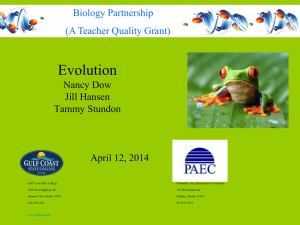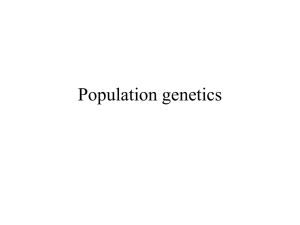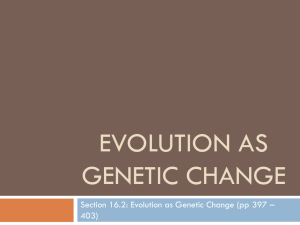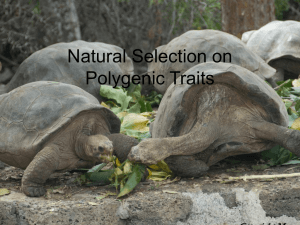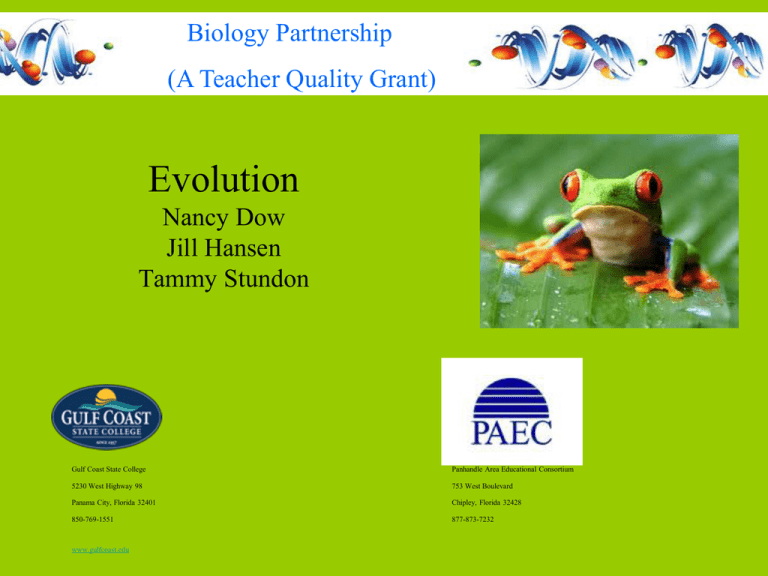
Biology Partnership
(A Teacher Quality Grant)
Evolution
Nancy Dow
Jill Hansen
Tammy Stundon
Gulf Coast State College
Panhandle Area Educational Consortium
5230 West Highway 98
753 West Boulevard
Panama City, Florida 32401
Chipley, Florida 32428
850-769-1551
877-873-7232
www.gulfcoast.edu
Pre-test
Breaks
Q & A boards
Our approach to the standards & to this lesson
Men in Black
Resources For New Teachers
•
•
•
•
•
Review Games
Biology EOC Review
Bay County Pacing Guide - 7 period Day
H.O.T Labs
Khan Academy
Florida Next Generation Sunshine
State Standards
• SC.912.L.15.13 Describe the conditions required
for natural selection, including: overproduction of
offspring, inherited variation, and the struggle to
survive, which result in differential reproductive
success. (MODERATE)
• SC.912.L.15.14 Discuss mechanisms of
evolutionary change other than natural selection
such as genetic drift and gene flow. (MODERATE)
• SC.912.L.15.15 Describe how mutation and genetic
recombination increase genetic variation.
(Moderate)
Benchmark Clarifications
– Students will explain and/or describe the conditions
required for natural selection that result in differential
reproductive success.
– Students will explain and/or describe the scientific
mechanisms, such as genetic drift, gene flow, and
nonrandom mating, resulting in evolutionary change.
– Students will explain and/or describe how mutation and
genetic recombination increase genetic variation.
– Students will identify ways in which a scientific claim is
evaluated (e.g., through scientific argumentation, critical
and logical thinking, and consideration of alternative
explanations).
Content Limits
– Items will not address descent with modification or common descent.
– Items addressing mutation and genetic recombination in relation to
increasing genetic variation must be assessed in the context of evolution.
– Items will not assess the Hardy-Weinberg principle or genetic equilibrium.
– Items may address how meiosis contributes to genetic variation but may
not assess the steps or stages of meiosis.
– Items assessing a scientific claim are limited to the topics discussed in
SC.912.L.15.13, SC.912.L.15.14, and SC.912.L.15.15.
Stimulus Attributes
None specified
Response Attributes
None specified
Prior Knowledge
• Items may require the student to apply scientific knowledge
described in the NGSSS from lower grades. This benchmark
requires prerequisite knowledge of SC.7.L.15.2, SC.7.L.15.3,
SC.7.L.16.1, SC.7.L.16.3, SC.7.L.17.3, SC.7.N.1.7, SC.6.N.2.2,
and SC.7.N.2.1.
Simpson Evolution Video
Natural selection content
• Lee Meadow’s “The Missing Link”
ISBN 13:978-0-325-07749-5
An inquiry approach for teaching all
students about evolution.
• Don’t say evolution is ‘just a theory’
• Many students feel they have to defend their
faith. Relieve that feeling.
• http://leemeadows.blogspot.com/
ADI Link
?
How long can a fruit fly
survive without food?
“SURVIVAL OF THE FITTEST”—ONLY THE ‘BEST’ FLY WILL SURVIVE
AND BE ABLE TO REPRODUCE AND PASS IT’S GENES ON TO THE NEXT
GENERATION.IT IS THEN SAID TO BE ‘FIT’-THIS IS NATURAL SELECTION.
Number of flies
AVERAGE STARVATION RESISTANCE
The average fruit fly
can survive about 20
hours without food.
A MORE
GENETICALLY
‘FIT’ FLY
GENETICALLY
‘UNFIT’” FLY
Hours until starvation
THE EXPERIMENT
= 500 fruit flies
Food removed
Food returned
Only the most starvationresistant flies live to lay eggs.
?
1 INITIAL SETUP
Start with a cage that
contains a large
number of fruit flies
(5,000), and remove
the food.
2 TESTING
STARVATION
RESISTANCE
Wait until 80% of the
starve to death,
Eggs flies
then return the food to
the cage. Record the
New generation average starvationresistance time.
Can fruit flies evolve so that they can
resist starvation longer? Can
we see Natural Selection at work? (YES)
3 START NEW
GENERATION
After the surviving flies
eat a bit, collect the eggs
those flies lay and
transfer them to a new
cage.
GENERATION 1
Average starvation resistance:
20 HR.
Hours until starvation
GENERATION 2
Average starvation resistance:
23 HR.
Hours until starvation
Experiment continues through 60 generations.
GENERATION 60
Average starvation resistance:
160 HR.---this is evolution
(change) at work
Number of flies
Number of flies
Number of flies
THE RESULTS
Hours until starvation
Over many generations of natural
selection, the population changes! The
flies now resist starvation much longer.
Natural Selection
Individuals with favorable
traits are more likely to leave
more offspring better suited
for their environment
Example:
English peppered
moth (Biston betularia)
Peppered Moth Lab
Peppered Moth Natural Selection Simulation
Peppered Moth Natural Selection Simulation
THE EVOLUTIONS OF POPULATIONS
THERE ARE FOUR
MECHANISMS THAT CAN
GIVE RISE TO EVOLUTION:
1.MUTATION
2.GENETIC DRIFT
3.MIGRATION (Gene Flow)
4.NATURAL SELECTION
Greatly and quickly seen in isolated populations like those on islands.
-Allele frequency will change over generations; situations/EVR will
favor one allele over another
-Those populations at equilibrium are not evolving
-Species with more genetic diversity will adapt better to environmental
changes
THE EVOLUTIONS OF POPULATIONS
Allele frequencies:
Proportion of orange furpigment alleles in the
population
Proportion of white furpigment alleles in the
population
Evolution is a change in the allele frequencies of a
population over time. For example, a change in the proportion
of pigment alleles in the population of tigers means that
evolution has occurred.
TIGER POPULATION
MUTATION
#1
A mutation can create
a new allele in an individual. MECHANISMS
When this happens, the
OF
population experiences a
EVOLUTION
change in its allele
frequencies and,
consequently, experiences
evolution.
Despite mutation’s vital role in
the generation of variation,
mutations almost always cause
early death or lower the
reproductive success of an
organism.
EVOLUTIONARY CHANGE: MUTATION
Mutagen
DNA
Normal basepair sequence
Mutated basepair sequence
Normal protein
Mutated protein
Normal
phenotype
Mutated
phenotype
Mutations
• Are rare because you have self correcting enzymes
• Natural Process that produces genetic diversity
• Not all mutations are bad
– Some won’t affect the body at all
• Blood types/ear lobes
– Some are advantageous
(thumb)
five
digit
s
wrist
bone
Argumentative Driven Inquiry
• Sex and the Single Guppy
– Guppy Sex Simulator
#2
GENETIC DRIFT
POPULATION BEFORE
GENETIC DRIFT
Allele frequencies:
cleft chin (dominant)
smooth chin (recessive)
Neither allele is
related to reproductive
success. Inheritance is
based solely on
chance.
POPULATION
AFTER GENETIC
DRIFT
There are now more
recessive alleles in the
population than
before.
MECHANISMS
OF EVOLUTION
GENETIC DRIFT
A population can experience
random changes in allele
frequency that do not influence
reproductive success and,
consequently, the population
experiences evolution.
REPRODUCTION
In this example, a heterozygous
couple (Cc) could have two children
that are homozygous recessive (cc),
causing an increase in the proportion
of recessive alleles in the
population.
FIXATION
Genetic drift leads to fixation when an allele’s frequency becomes
100% in a population. If this occurs, there is no longer genetic
variation for the gene.
#2
GENETIC DRIFT: FOUNDER EFFECT
SOURCE POPULATION
Allele frequencies:
5 digits per hand
(recessive)
>5 digits per hand
(dominant)
A group of individuals may leave a
population and become the founding
members of a new, isolated population.
NEWLY FOUNDED
POPULATION
The new population will be
dominated by the genetic features
present in the founding members.
MECHANISMS
OF EVOLUTION
FOUNDER EFFECT
The founding members of a new
population can have different
allele frequencies than the
original source population and,
consequently, the new
population experiences
evolution.
AMISH
#2
GENETIC DRIFT: BOTTLENECK EFFECT
Occasionally, famine or disease or rapid environmental change may
cause the deaths of a large, random proportion of the individuals in a
population.
SOME CATASTROPHE
SOURCE POPULATION
MECHANISMS
OF EVOLUTION
BOTTLENECK EFFECT
Occasionally, famine or
disease or rapid environmental
change may cause the deaths
of a large, random proportion
of the individuals in a
population.
EXTREME AND RAPID
ENVIRONMENTAL CHANGE
NEW POPULATION
The new population will be
dominated by the genetic
features present in the
surviving members.
Unless more individuals are introduced to the
population, mating options will be limited thus
decreasing variation in the gene pool
(decreasing genetic diversity).
All cheetahs living today can trace
their ancestry back to a dozen or so
individuals that happened to survive a
population bottleneck about 10,000
years ago!
Genetic Drift Activity
#3 MECHANISMS
MIGRATION (GENE FLOW)
1 BEFORE MIGRATION
Two populations of the same species exist in
separate locations. In this example, they are
separated by a mountain range.
Population 1
OF EVOLUTION
MIGRATION
After a group of individuals
migrates from one population
to another, both populations
can experience a change in
their allele frequencies and,
consequently, experience
evolution.
Population 2
#3
MIGRATION (GENE FLOW)
2 MIGRATION
A group of individuals from Population 1
migrates over the mountain range.
Population 1
MECHANISMS
OF EVOLUTION
MIGRATION
After a group of individuals
migrates from one population
to another, both populations
can experience a change in
their allele frequencies and,
consequently, experience
evolution.
Population 2
#3
MIGRATION (GENE FLOW)
MECHANISMS
OF EVOLUTION
MIGRATION
After a group of individuals
migrates from one population
to another, both populations
can experience a change in
their allele frequencies and,
consequently, experience
evolution.
3 AFTER MIGRATION
The migrating individuals are able to survive and
reproduce in the new population and they may
experience evolutionary changes from population 1.
Population 1
Population 2
#4
Mechanism of
evolution
Natural Selection
1. VARIATION OF A TRAIT IN A POPULATION
3 Conditions that must
occur for Natural Selection
The tiniest dog in a litter has
reduced differential
reproductive success. Its
more robust siblings prevent
access to the food it needs to
grow and thrive.
2. The trait must be inheritable
3. One version of the trait must be in greater
abundance than a different version of the trait.
4. Natural Selection
There is indirect and direct evidence of
I. Indirect – we find it, not witness it
II. Direct – we are witness to the development of
-Will be seen when there is:
1.Over population
2.Inheritance variation
3.Struggle for survival (abiotic factors too)
1.Fossils
2.Comparative Anatomy
3.Adaptation
Evidence:
4. Embryos
5. Biogeography
6. Field/lab Experiments
Evidence of NS: Adaption
The honeycreepers of Hawaii have adapted to a wide range of
habitats, yet still closely resemble a finch-like shared ancestor found
nearly 2,000 miles away---the major difference is the bill .
BIOGEOGRAPHY: HAWAIIAN HONEYCREEPERS
Mainland finch
(probable
shared
ancestor)
’Akeke’e
honeycreeper
BIOGEOGRAPHY:
Maui Parrotbill
honeycreeper
HONEYCREEPERS--A MODERN DAY
DARWIN’S FINCH
SCENARIO
’I’iwi
honeycreeper
Evidence of NS: biogeography
PLACENTAL COUNTERPARTS
AUSTRALIAN MARSUPIALS
BIOGEOGRAPHY: AUSTRALIAN MARSUPIALS AND THEIR PLACENTAL COUNTERPARTS
Sugar glider
Numbat
Tasmanian wolf
Gray squirrel
Giant anteater
Gray wolf
Though less related to each other than you are to a shrew,
these marsupials and their placental counterparts (both
mammals) have come to resemble each other as natural
selection has adapted them to similar habitats.
EVOLUTION BY NATURAL SELECTION: A SUMMARY
1 VARIATION
FOR A TRAIT
Different traits are present
in individuals of the same
species
2 HERITABILITY
Traits are passed on from
parents to their children.
MECHANISMS
OF EVOLUTION
NATURAL SELECTION
When these three conditions
are satisfied, the population’s
allele frequencies change and,
consequently, evolution by
natural selection occurs.
3 DIFFERENTIAL
REPRODUCTIVE SUCCESS
In a population, individuals with traits
most suited to reproduction in their
environment generally leave more
offspring than individuals with other
traits.
NATURAL SELECTION IN NATURE
Running speed in rabbits
can vary from one
individual to the next.
1 VARIATION FOR A TRAIT
The trait of running speed is
passed on from parents to
their offspring.
2 HERITABILITY
In a population, rabbits with
slower running speeds are
eaten by the fox and their
traits are not passed on to
the next generation.
3 DIFFERENTIAL
REPRODUCTIVE SUCCESS
Speed
EVOLUTION OF ANTIBIOTIC RESISTANCE
Most of the
Staphylococcus
is killed.
When first used as medicine in the 1940s, penicillin was
uniformly effective in killing the bacterium Staphylococcus
aureus. Today, natural selection has led to an increase in
antibiotic-resistant alleles, and humans are increasingly at
risk from untreatable Staphylococcus infections.(this is
ongoing evolution taking place right now )
Penicillin Staphylococcus
Kill zone
Very little of the
Staphylococcus
is killed.
1940s
Today
A single species of grass
is planted on a golf
course. On the putting
greens, it is cut very
frequently / on the
fairways it is cut only
occasionally / in the
rough it is almost never
cut at all.
EVOLUTION IN PROGRESS: GREEN GRASS ON A GOLF COURSE
Over the course of
Rough
Fairway
Putting green
SELECTIVE
PRESSURE
Monthly mowing
schedule
SEXUAL
MATURATION
SLOWEST
SLOW
RAPID
SEED
PRODUCTION
LOWEST
LOW
HIGH
only a few years,
grass plants from the
same stock had
developed into three
distinct populations
as a result of the
frequency at which
they were cut.
LIFE IS SHORT
SO MUST
REPRODUCE
RAPIDLY
WITH LARGE
SEED
PRODUCTION
Evolution does not work this way
• Wooly Worm lab
– Outside activity
Follow-up
• Q/A Board
• Problem solving issues in class
• Additional activities:
– Understanding Evolution website- Berkley
– Evolution of Cetaceans
Florida Next Generation Sunshine
State Standards
• SC.912.L.15.1* Explain how the scientific theory of
evolution is supported by the fossil record, comparative
anatomy, comparative embryology, biogeography,
molecular biology, and observed evolutionary change.
(HIGH)
• SC.912.L.15.10 Identify basic trends in hominid evolution
from early ancestors six million years ago to modern
humans, including brain size, jaw size, language, and
manufacture of tools. (Moderate)
• (Also assesses SC.912.N.1.3, SC.912.N.1.4,
SC.912.N.1.6, SC.912.N.2.1, SC.912.N.3.1, and
SC.912.N.3.4.)
High Complexity 10% - 20%
• High complexity benchmarks make heavy demands on
student thinking. Students must engage in more abstract
reasoning, planning, analysis, judgment, and creative
thought. These benchmarks require students to think in an
abstract and sophisticated way, often involving multiple
steps. Skills related to high complexity benchmarks include
the following.
• Construct models for research.
• Generalize or draw conclusions.
• Design an experiment, given data and conditions.
• Explain or solve a problem in more than one way.
• Provide a justification for steps in a solution or process.
• Analyze an experiment to identify a flaw and propose a
method for correcting it.
• Interpret, explain, or solve a problem involving complex
spatial relationships.
• Predict a long-term effect, outcome, or result of a change
within a system
Item Specs
Benchmark Clarifications
– Students will identify evidence and/or explain how the scientific theory of
evolution is supported by the fossil record, comparative anatomy, comparative
embryology, biogeography, molecular biology, and observable evolutionary
change.
– Students will identify examples of and basic trends in hominid evolution from
early ancestors to modern humans. (e.g., through scientific argumentation,
critical and logical thinking, and consideration of alternative explanations).
– Students will assess the reliability of sources of information according to
scientific standards.
– Students will describe how scientific inferences are made from observations and
identify examples from biology.
– Students will identify what is science, what is not science, and what resembles
but fails to meet the criteria for science.
– Students will explain the development of a theory.
– Students will recognize the differences between theories and laws.
Content Limits
– Items assessing evolution will focus on a conceptual
understanding of the supporting scientific evidence.
– Items will not require memorization of the names of specific
human fossils or the names of the different hominid species.
– Items assessing the fossil record must focus on the fossil
rather than geologic formations in isolation.
– Items assessing the fossil record will not require
understanding of the specific mechanisms used for relative
dating and radioactive dating.
– Items will not require the memorization of the geologic time
scale, including era, period, and/or epoch.
– Items will not assess the origin of Earth.
– Items will not assess specific knowledge of the formation of
microspheres or the evolution of RNA and DNA.
– Items will not address or assess the endosymbiotic theory.
– Items referring to adaptive radiation, convergent evolution,
coevolution, or punctuated equilibrium should focus on the
concepts rather than on the definition of the terms.
– Items referring to the development of language or the
manufacturing of tools will relate this development to
changes in the skull or brain size.
– Items will not assess types of genetic mutation or how these
mutations occur.
– Items referring to comparative anatomy and comparative
embryology will assess anatomical similarities such as
homologous structures and vestigial organs but will not
require specific knowledge of embryologic stages or
structures.
– Items will not require knowledge of changes to specific
species or geographic location of those species
– Items will not assess genes, alleles, genetic drift, or gene flow.
– Items may assess how the overall contributions of scientists such as Darwin,
Lamarck, Lyell, Malthus, Mendel, or Wallace aided in the development of the
scientific theory of evolution.
– Items will not assess the differences among intelligent design, creationism, and
the scientific theory of evolution.
– Items assessing a scientific claim, the development of a theory, or the
differences between theories and laws are limited to the scientific theory of
evolution.
Stimulus Attributes
– Scenarios referring to specific species will include a description of the species in
relation to context of the item.
– Scenarios addressing scientific inferences are limited to the scientific theory of
evolution and trends in hominid evolution.
Response Attributes
Prior Knowledge
None specified
– Items may require the student to apply scientific knowledge described in the
NGSSS from lower grades. This benchmark requires prerequisite knowledge of
SC.7.L.15.1, SC.7.L.15.2, SC.7.L.15.3, SC.8.E.5.10, SC.6.N.2.1, SC.6.N.2.2,
SC.6.N.3.1, SC.6.N.3.2, SC.6.N.3.3, SC.7.N.1.6, SC.7.N.1.7, SC.7.N.2.1,
SC.7.N.3.1, SC.8.N.1.6, SC.8.N.2.1, SC.8.N.2.2, and SC.8.N.3.2.
Bell ringer
Evidence of Evolution
1.
2.
3.
4.
5.
6.
Fossils
Embryos
Comparative Anatomy
Biogeography
Adaptation
Field/lab Experiments
Evidence for evolution in Darwin’s
time came from several sources.
• Fossils provide evidence of evolution.
• Fossils in older layers are more primitive than
those in the upper layers.
The evolutionary history of horses is among the most well preserved in the fossil record.
Because of this record, we know that since first appearing around 55 million years ago, there
have been many branches to the horse’s evolutionary tree, a sample of which is shown here.
EVOLUTIONARY HISTORY OF HORSES
Evidence of NS:
Fossil Records
Anchitheres
EXTINCT
Time
Hyracotherium
EXTINCT
Orohippus
EXTINCT
Equus
(modern
horse)
ALIVE
TODAY
Miohippus
EXTINCT
Mesohippus
EXTINCT
Merychippus
EXTINCT
THE FIRST HORSE WAS DOG-SIZE, AND THE OTHER EARLY HORSES
HAD TOES. ALSO THE ENAMEL ON THE EARLY HORSES TEETH
WAS TOO SOFT TO EAT GRASS WHICH CONTAINS SILICA (GLASS).
THE MODERN HORSE HAS HOOVES, THICKER ENAMEL AND ARE LARGER
TIKTAALIK: “THE MISSING LINK”
Homologous
structures
Lobe-finned Tiktaalik
fish
A MISSING LINK IS A
FOSSIL THAT SHOWS A
‘LINK’ BETWEEN GROUPS
OF SPECIES THAT MAY
HAVE SHARED A
COMMON ANCESTOR
Early
amphibian
Tiktaalik fossils have gills, scales, and fins, like
fish, but arm-like joints resembling those in
amphibians.
• The study of geography provides evidence of
evolution.
– island species most closely resemble nearest mainland species
– populations can show variation from one island to another
• Embryology provides evidence of evolution.
– identical larvae, different adult body forms
Larva
Adult crab
Adult barnacle
Comparative embryology:
Similar embryo development in closely related species
similar embryos, diverse organisms
Homologous structures are evidence of a common ancestor.
HOMOLOGOUS BONE STRUCTURES
Humerus
Radius
Ulna
Phalanges
Metacarpals
Carpals
Human
Horse
Bat
Porpoise
The similarities in the bone structure of the
COMPARATIVE
ANATOMY
These are Homologous
structures
forelimbs of mammals demonstrate Figure 8-38
Evidence for evolution: comparative anatomy.
common ancestry.
• The study of anatomy provides evidence of evolution.
– Analogous structures have a similar function.
– Analogous structures are not evidence of a common
ancestor but of common environmental pressure
Fly wing
Bat wing
Molars continue to
grow in vampire
bats, even though
they consume a
completely liquid
diet!
Molars
Vampire bat skull
Thigh Bones of a snake
PELVIS & STUNTED
LEGS ON A MODERN
WHALE
Vestigial Structures:
Structures not used and are disappearing on a species
VESTIGIAL CAUDAL APPENDANGES (TAILS)
Comparative Biochemistry
• Similar DNA sequences
• Similar gene segments
of the DNA
– code for similar traits
– closely related species
Bell ringer
• Friends Evolution Montage
Humans appeared late in Earth’s history.
Humans share a common ancestor with other primates.
• Primates are mammals with flexible hands and
feet, forward-looking eyes and enlarged brains.
• Primates evolved into prosimians and
anthropoids.
– Prosimians are the oldest living primates.
– They are mostly small and nocturnal.
Anthropoids are humanlike primates.
– They are subdivided into the New World monkeys, Old
World monkeys, and hominoids.
– Homonoids are
divided into
hominids, great
apes, and lesser
apes.
– Hominids
include living
and extinct
humans.
• Bipedal means walking on two legs.
– foraging
– carrying infants and food
– using tools
• Walking upright has
important adaptive
advantages.
• Disadvantages?
There are many fossils of extinct hominids.
• Most hominids are
either the genus
Australopithecus or
Homo.
• Australopithecines
were a successful
genus.
• The Homo genus first
evolved 2.4 million
years ago.
Sahelanthropus tchadenis
7-million year old skull
fragments found in Africa
Comparing Hominids
• Over time, the jaws of hominid species
evolved to be smaller, lighter and less
protruding. Scientist are now collecting
evidence to support the theory that this
change in jaw size allowed for larger brains
to develop in hominids.
• Virtual Lab
– Comparing Hominid skulls
– Jaw, skull, brain, language, tools – computer
program – www.classzone.com
Paper Lab
– Human Versus Primate Traits
Follow-up
• Q/A Board
• Problem solving issues in class
• Additional activities:
–
–
–
–
Becoming Human Interactive-documentary
Human Thumb Activity
eSkeletons.org
eFossils.org or eLucy.org Glossary
EOC Study Guide
•SC.912.L.15.1
•SC.912.L.15.10
Explain how the scientific theory of evolution is supported by the fossil
record, comparative anatomy, comparative embryology, biogeography,
molecular biology, and observed evolutionary change.
H
Identify basic trends in hominid evolution from early ancestors six million
years ago to modern humans, including brain size, jaw size, language, and
manufacture of tools. M
•SC.912.L.15.13
Describe the conditions required for natural selection, including:
overproduction of offspring, inherited variation, and the struggle to survive,
which result in differential reproductive success.
•SC.912.L.15.14
M
Discuss mechanisms of evolutionary change other than natural selection
such as genetic drift and gene flow.
» 1. Define genetic drift. Discuss how population size affects genetic
variability due to genetic drift
» 2. Define gene flow
M
Post Test
AND GIVE-AWAYS!!!!





